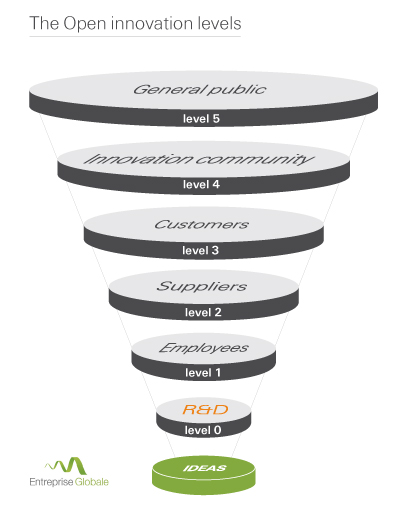 During decades, innovation has been a locked in process within organizations. In Europe, more and more enterprises are looking for new innovation field to overtake the crisis. If there is a long time that US enterprises like Starbuck or General Electric are crowdsourcing oriented, it’s less common here in Europe (even if examples exist like Daimler or Tchibo)….
During decades, innovation has been a locked in process within organizations. In Europe, more and more enterprises are looking for new innovation field to overtake the crisis. If there is a long time that US enterprises like Starbuck or General Electric are crowdsourcing oriented, it’s less common here in Europe (even if examples exist like Daimler or Tchibo)….
Let’s have a look on the basics for external open innovation, to highlight the first steps for these enterprises.
In recent years, the company walls fell to accelerate the innovation and creation. The goal is to have new ideas for new products or services, faster and at a lower cost, using its network of suppliers, external experts, see clients, with at the key a reward hard cash. In the context of a learning curve, it is not too early to begin to worry about.
Many companies like Boeing, HP or Apple to make their products use components invented by many suppliers around the world. For a long time, companies incorporate the ideas of their customers through their customer service, consumer groups and test their prototypes to some customers before developing at a large scale. Give a greater scope for decision making about the purpose of the product does not seem totally inconsistent, IBM had understood that. When the company turned to Linux, most communities working on its development did not work for IBM, which did not prevent the latter to profit and vice versa. There was a real partnership « win-win ».
Companies have three ways to take advantage of this co-creation:
- Use customers and partners network to generate new ideas
- Produce additional services in the form of packages, as is the case of open source softwares
- Indirectly take part in the process of co-creation using the brand awareness to disseminate
For companies that must meet many challenges:
- Attract and motivate contributors, for recognition, not necessarily just financial. But also to develop this network of contributors
- Know how to partition the problem, in order to allow a maximum of contributors to invest in the area where they excel, without master the full problem
- Manage and co-organize the creation, through a transparent process and accepted by all
- Search quality by the plurality of views
- Reflect the views of professional communities and consumers
If money and recognition engines are obviously co-creation for consumers communities, it seems that the idea of seeing their opinions lead to concrete results is equally important. Of course this is only possible through a brand that enjoys. The « fun » is a powerful driving force within these communities.
Establish a process of co-creation requires not totally review its organization. But some people are able to identify opportunities for collaboration technologies, markets, or identify people who might come into contact to develop these areas for improvement. It is often enough to identify with stakeholders who can initiate this process. If this is in the early stages, the « pioneers » will be able to take full advantage of this process when  it will be mature, while others are still trying to understand the mechanisms. This approach is based on this idea more prosaically as « wisdom of crowds » which is to say that « We are smarter than me. »
But it’s obvious that a real shaping of the internal organization to improve open innovation is a real asset. We’ll see that in another post.
